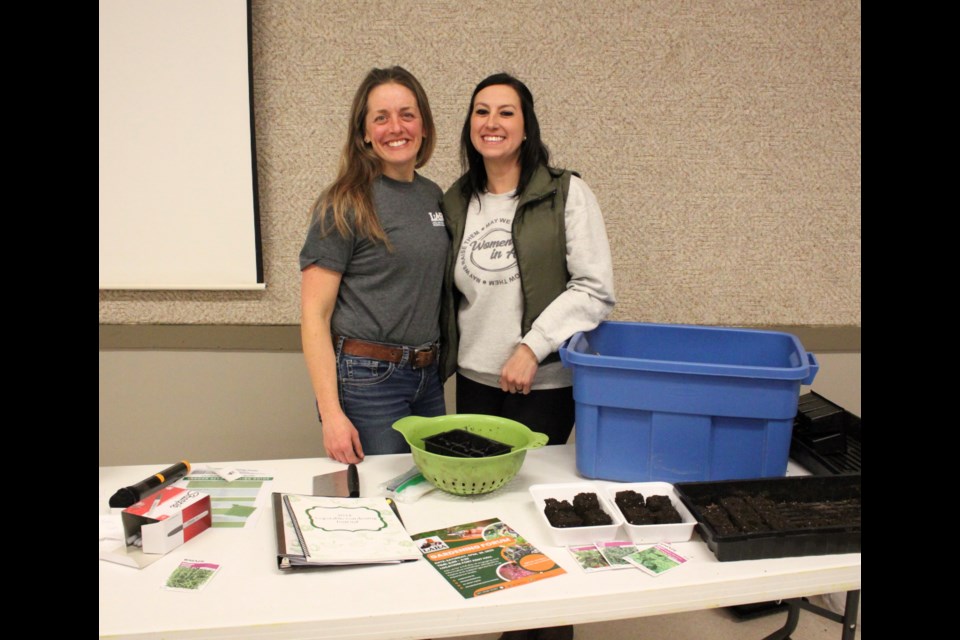EASTBOURNE – The Lakeland Agricultural Research Association (LARA) drew a large crowd of both seasoned and beginner gardeners for a seed starting workshop featuring guest speaker Krista Green from Zone 3 Vegetable Gardening.
Organizer Kristy Tetreau said they were thrilled to see such a great turnout with 74 participants.
“Workshops like these provide a fantastic opportunity to connect with local gardeners, share knowledge, and promote sustainable growing practices in our region. Whether attendees were experienced growers or just starting their first garden, it was inspiring to see so much enthusiasm for learning and growing local food,” said Tetreau.
The workshop was held at the Eastbourne Community Hall on Jan. 28 and included dinner and the opportunity to mingle with other gardening enthusiasts.
Tetreau welcomed the crowd and explained that an influx of registrations over the weekend meant they had to adjust their seed starting activity to accommodate the large number of people.
She demonstrated the use of a soil blocker, which eliminates the need for individual containers, and had attendees plant their own herbs to take home.
Tetreau offered a special thank you to the MD of Bonnyville, County of St. Paul, Smoky Lake County, and municipal funders for their support in making the seed starting workshop a success.
“We look forward to hosting more hands-on learning opportunities and continuing to support our community in building resilient, productive gardens,” said Tetreau.
Gardening tips
Green’s presentation on seed starting had several seasoned gardeners commenting on the wealth of helpful tips she offered.
Green, who has 10 years of experience working in greenhouses, explained that you do not need a lot of fancy supplies to get started, explaining how she started with plastic containers sitting in a windowsill.
Instead of expensive grow lights, Green uses full spectrum white shop lights at 5000 lumens, and has had success with them. As long as your space is 20 degrees Celsius or warmer, you don’t need warming mats, adds Green.
Fourteen to 16 hours of light per day is ideal for growing, and Green recommends using a Christmas tree light timer to automatically set the lighting intervals for plants.
The importance of having sterile potting soil in order to avoid pests and mold was highlighted. In the past, Green experimented with using sterilized soil versus garden soil to start seeds, as she was aware of the benefits of the microbiome that is in healthy soil.
“My instructor told me to not be surprised if I don’t have the outcome I expected, and sure enough my seeds that I started in sterile soil had better germination rates. The ones in sterile soil had an extra leaf or two after six weeks compared to the ones in the other soil,” said Green.
When choosing seeds, Green said opt for new seeds and consider purchasing them from companies that grow in a similar climate to yours. With a short growing season in northeastern Alberta, selecting varieties that have fewer days to reach maturity can be helpful.
If you store seeds, Green suggested storing them with silica packets you get with products such as vitamins, to keep them dry.
When discussing fertilizers, Green said to start fertilizing your seedlings after four to six weeks, then fertilize every two to three weeks.
She also explained how to navigate the sequence of numbers on fertilizers products: the number order always represents the ratio of nitrogen, phosphorous, and potassium.
“These are the three main nutrients required for plant growth all around, but there are parts of the plant each one effects more than others. Nitrogen especially affects leaf production, phosphorous is super important for root growth, whereas potassium is for blossoming . . . A cheat when you’re looking at these three numbers that I love is: up, down, around,” said Green.
She also recommended labeling plants, and if you don’t want to purchase plant labels you can make them out of old plastic containers.
“I can’t tell you how many times I’ve thought, ‘Oh, I’ll remember this one,’ and then it begins to grow, and I have no idea what it is,” said Green.



